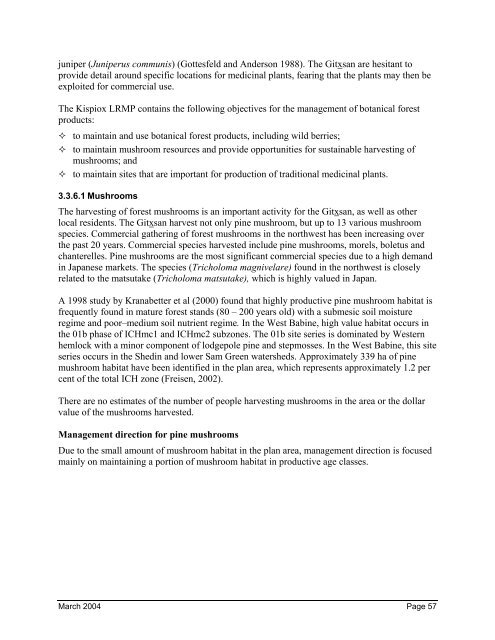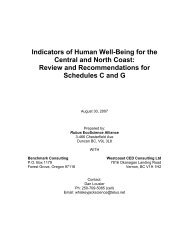West Babine Sustainable Resource Management Plan
West Babine Sustainable Resource Management Plan
West Babine Sustainable Resource Management Plan
Create successful ePaper yourself
Turn your PDF publications into a flip-book with our unique Google optimized e-Paper software.
juniper (Juniperus communis) (Gottesfeld and Anderson 1988). The Gitxsan are hesitant to<br />
provide detail around specific locations for medicinal plants, fearing that the plants may then be<br />
exploited for commercial use.<br />
The Kispiox LRMP contains the following objectives for the management of botanical forest<br />
products:<br />
to maintain and use botanical forest products, including wild berries;<br />
to maintain mushroom resources and provide opportunities for sustainable harvesting of<br />
mushrooms; and<br />
to maintain sites that are important for production of traditional medicinal plants.<br />
3.3.6.1 Mushrooms<br />
The harvesting of forest mushrooms is an important activity for the Gitxsan, as well as other<br />
local residents. The Gitxsan harvest not only pine mushroom, but up to 13 various mushroom<br />
species. Commercial gathering of forest mushrooms in the northwest has been increasing over<br />
the past 20 years. Commercial species harvested include pine mushrooms, morels, boletus and<br />
chanterelles. Pine mushrooms are the most significant commercial species due to a high demand<br />
in Japanese markets. The species (Tricholoma magnivelare) found in the northwest is closely<br />
related to the matsutake (Tricholoma matsutake), which is highly valued in Japan.<br />
A 1998 study by Kranabetter et al (2000) found that highly productive pine mushroom habitat is<br />
frequently found in mature forest stands (80 – 200 years old) with a submesic soil moisture<br />
regime and poor–medium soil nutrient regime. In the <strong>West</strong> <strong>Babine</strong>, high value habitat occurs in<br />
the 01b phase of ICHmc1 and ICHmc2 subzones. The 01b site series is dominated by <strong>West</strong>ern<br />
hemlock with a minor component of lodgepole pine and stepmosses. In the <strong>West</strong> <strong>Babine</strong>, this site<br />
series occurs in the Shedin and lower Sam Green watersheds. Approximately 339 ha of pine<br />
mushroom habitat have been identified in the plan area, which represents approximately 1.2 per<br />
cent of the total ICH zone (Freisen, 2002).<br />
There are no estimates of the number of people harvesting mushrooms in the area or the dollar<br />
value of the mushrooms harvested.<br />
<strong>Management</strong> direction for pine mushrooms<br />
Due to the small amount of mushroom habitat in the plan area, management direction is focused<br />
mainly on maintaining a portion of mushroom habitat in productive age classes.<br />
March 2004 Page 57

















